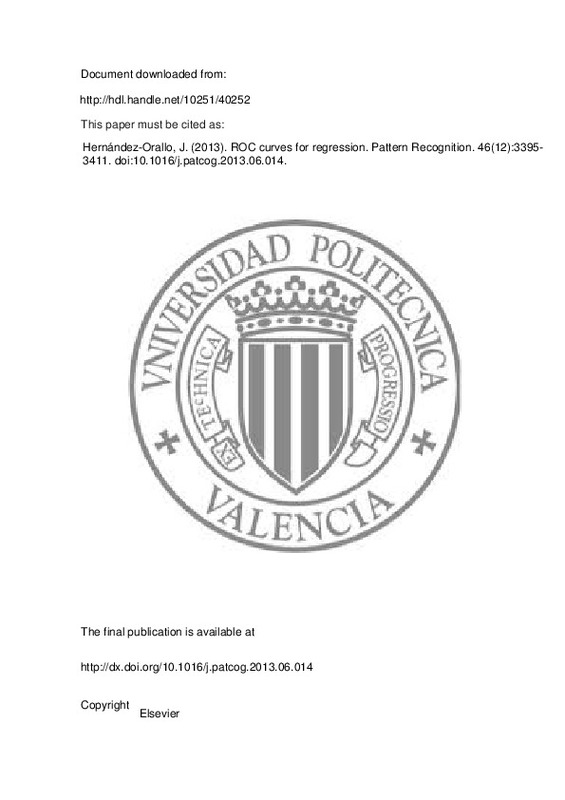Hernández-Orallo, J. (2013). ROC curves for regression. Pattern Recognition. 46(12):3395-3411. https://doi.org/10.1016/j.patcog.2013.06.014
Por favor, use este identificador para citar o enlazar este ítem: http://hdl.handle.net/10251/40252
|
Título:
|
ROC curves for regression
|
|
Autor:
|

 Hernández-Orallo, José
Hernández-Orallo, José
|
|
Entidad UPV:
|
Universitat Politècnica de València. Departamento de Sistemas Informáticos y Computación - Departament de Sistemes Informàtics i Computació
|
|
Fecha difusión:
|
|
|
Resumen:
|
Receiver Operating Characteristic (ROC) analysis is one of the most popular tools for the visual assessment and understanding of classifier performance. In this paper we present a new representation of regression models ...[+]
Receiver Operating Characteristic (ROC) analysis is one of the most popular tools for the visual assessment and understanding of classifier performance. In this paper we present a new representation of regression models in the so-called regression ROC (RROC) space. The basic idea is to represent over-estimation against under-estimation. The curves are just drawn by adjusting a shift, a constant that is added (or subtracted) to the predictions, and plays a similar role as a threshold in classification. From here, we develop the notions of optimal operating condition, convexity, dominance, and explore several evaluation metrics that can be shown graphically, such as the area over the RROC curve (AOC). In particular, we show a novel and significant result: the AOC is equivalent to the error variance. We illustrate the application of RROC curves to resource estimation, namely the estimation of software project effort.
[-]
|
|
Palabras clave:
|
ROC curves
,
Cost-sensitive regression
,
Operating condition
,
Asymmetric loss
,
Error variance
,
MSE decomposition
|
|
Derechos de uso:
|
Reserva de todos los derechos
|
|
Fuente:
|
Pattern Recognition. (issn:
0031-3203
)
|
|
DOI:
|
10.1016/j.patcog.2013.06.014
|
|
Editorial:
|
Elsevier
|
|
Versión del editor:
|
http://dx.doi.org/10.1016/j.patcog.2013.06.014
|
|
Código del Proyecto:
|
info:eu-repo/grantAgreement/MEC//CSD2007-00022/ES/Agreement Technologies/
info:eu-repo/grantAgreement/MICINN//TIN2010-21062-C02-02/ES/SWEETLOGICS-UPV/
info:eu-repo/grantAgreement/Generalitat Valenciana//PROMETEO08%2F2008%2F051/ES/Advances on Agreement Technologies for Computational Entities (atforce)/
|
|
Descripción:
|
“NOTICE: this is the author’s version of a work that was accepted for publication in Pattern Recognition. Changes resulting from the publishing process, such as peer review, editing, corrections, structural formatting, and other quality control mechanisms may not be reflected in this document. Changes may have been made to this work since it was submitted for publication. A definitive version was subsequently published in Pattern Recognition Volume 46, Issue 12, December 2013, Pages 3395–3411
DOI: 10.1016/j.patcog.2013.06.014
|
|
Agradecimientos:
|
I would like to thank Peter Flach and Nicolas Lachiche for some very useful comments and corrections on earlier versions of this paper, especially the suggestion of drawing normalised curves (dividing x-axis and y-axis by ...[+]
I would like to thank Peter Flach and Nicolas Lachiche for some very useful comments and corrections on earlier versions of this paper, especially the suggestion of drawing normalised curves (dividing x-axis and y-axis by n). This work was supported by the MEC/MINECO projects CONSOLIDER-INGENIO CSD2007-00022 and TIN 2010-21062-C02-02, GVA project Prometeo/2008/051, the COST - European Cooperation in the field of Scientific and Technical Research IC0801 AT, and the REFRAME project granted by the European Coordinated Research on Long-term Challenges in Information and Communication Sciences & Technologies ERA-Net (CHIST-ERA), and funded by the respective national research councils and ministries.
[-]
|
|
Tipo:
|
Artículo
|







![[Cerrado]](/themes/UPV/images/candado.png)


